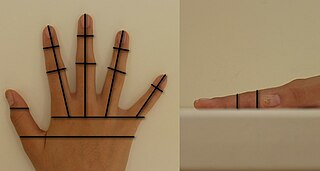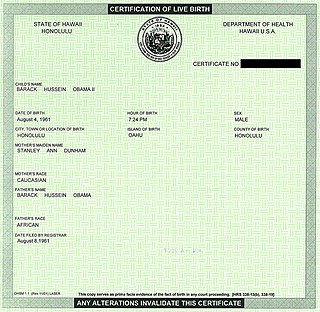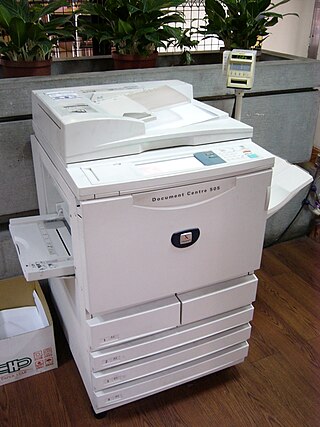Malware is any software intentionally designed to cause disruption to a computer, server, client, or computer network, leak private information, gain unauthorized access to information or systems, deprive access to information, or which unknowingly interferes with the user's computer security and privacy. Researchers tend to classify malware into one or more sub-types.
Steganography is the practice of representing information within another message or physical object, in such a manner that the presence of the information is not evident to human inspection. In computing/electronic contexts, a computer file, message, image, or video is concealed within another file, message, image, or video. The word steganography comes from Greek steganographia, which combines the words steganós, meaning "covered or concealed", and -graphia meaning "writing".

Authentication is the act of proving an assertion, such as the identity of a computer system user. In contrast with identification, the act of indicating a person or thing's identity, authentication is the process of verifying that identity. It might involve validating personal identity documents, verifying the authenticity of a website with a digital certificate, determining the age of an artifact by carbon dating, or ensuring that a product or document is not counterfeit.

A barcode reader or barcode scanner is an optical scanner that can read printed barcodes, decode the data contained in the barcode on a computer. Like a flatbed scanner, it consists of a light source, a lens, and a light sensor for translating optical impulses into electrical signals. Additionally, nearly all barcode readers contain decoder circuitry that can analyse the barcode's image data provided by the sensor and send the barcode's content to the scanner's output port.

The EURion constellation is a pattern of symbols incorporated into a number of secure documents such as banknotes, checks, and ownership title certificates designs worldwide since about 1996. It is added to help imaging software detect the presence of such a document in a digital image. Such software can then block the user from reproducing banknotes to prevent counterfeiting using colour photocopiers.

Security printing is the field of the printing industry that deals with the printing of items such as banknotes, cheques, passports, tamper-evident labels, security tapes, product authentication, stock certificates, postage stamps and identity cards. The main goal of security printing is to prevent forgery, tampering, or counterfeiting. More recently many of the techniques used to protect these high-value documents have become more available to commercial printers, whether they are using the more traditional offset and flexographic presses or the newer digital platforms. Businesses are protecting their lesser-value documents such as transcripts, coupons and prescription pads by incorporating some of the features listed below to ensure that they cannot be forged or that alteration of the data cannot occur undetected.

A QR code is a type of two-dimensional matrix barcode, invented in 1994, by Japanese company Denso Wave for labelling automobile parts. A QR code consists of black squares arranged in a square grid on a white background, including some fiducial markers, which can be read by an imaging device, such as a camera, and processed using Reed–Solomon error correction until the image can be appropriately interpreted. The required data are then extracted from patterns that are present in both the horizontal and the vertical components of the QR image.
A digital watermark is a kind of marker covertly embedded in a noise-tolerant signal such as audio, video or image data. It is typically used to identify ownership of the copyright of such signal. "Watermarking" is the process of hiding digital information in a carrier signal; the hidden information should, but does not need to, contain a relation to the carrier signal. Digital watermarks may be used to verify the authenticity or integrity of the carrier signal or to show the identity of its owners. It is prominently used for tracing copyright infringements and for banknote authentication.

Identity document forgery is the process by which identity documents issued by governing bodies are copied and/or modified by persons not authorized to create such documents or engage in such modifications, for the purpose of deceiving those who would view the documents about the identity or status of the bearer. The term also encompasses the activity of acquiring identity documents from legitimate bodies by falsifying the required supporting documentation in order to create the desired identity.

Hand geometry is a biometric that identifies users from the shape of their hands. Hand geometry readers measure a user's palm and fingers along many dimensions including length, width, deviation, and angle and compare those measurements to measurements stored in a file.

Security paper is a paper used in security printing that incorporates features that can be used to identify or authenticate a document as original, e.g., watermarks or invisible fibres in paper, or features that demonstrate tamper evidence when fraud is attempted, e.g., to remove or alter print such as amounts or signatures on a cheque. Examples of this kind of papers are used for banknotes and used for identification such as passports and certificates, such as birth certificates and different types of academic and qualification certificates, as well as government documents, e.g., voting ballots and tax strips. This also extends to personal and business checks, stock certificates, certificates issued by financial institutions and sensitive government-issued documents. The main use of security paper is to stop people from counterfeiting.

A photocopier is a machine that makes copies of documents and other visual images onto paper or plastic film quickly and cheaply. Most modern photocopiers use a technology called xerography, a dry process that uses electrostatic charges on a light-sensitive photoreceptor to first attract and then transfer toner particles onto paper in the form of an image. The toner is then fused onto the paper using heat, pressure, or a combination of both. Copiers can also use other technologies, such as inkjet, but xerography is standard for office copying.

Brand protection is the process and set of actions that a right holder undertakes to prevent third parties from using its intellectual property without permission, as this may cause loss of revenue and, usually more importantly, destroys brand equity, reputation and trust. Brand protection seeks primarily to ensure that trademarks, patents, and copyrights are respected, though other intellectual property rights such as industrial design rights or trade dress can be involved. Counterfeiting is the umbrella term to designate infringements to intellectual property, with the exception of the term piracy which is sometimes (colloquially) used to refer to copyright infringement.

Optical braille recognition is technology to capture and process images of braille characters into natural language characters. It is used to convert braille documents for people who cannot read them into text, and for preservation and reproduction of the documents.
Copy-evident documents have features that make it detectable that a copy is not the original.
Perceptual hashing is the use of a fingerprinting algorithm that produces a snippet, hash, or fingerprint of various forms of multimedia. A perceptual hash is a type of locality-sensitive hash, which is analogous if features of the multimedia are similar. This is in contrast to cryptographic hashing, which relies on the avalanche effect of a small change in input value creating a drastic change in output value. Perceptual hash functions are widely used in finding cases of online copyright infringement as well as in digital forensics because of the ability to have a correlation between hashes so similar data can be found.
AlfonsoFarinaFREng is an Italian electronic engineer and former industry manager. He is most noted for the development of the track while scan techniques for radars and generally for the development of a wide range of signal processing techniques used for sensors where tracking plays an essential role. He is author of about 1000 publications. His work was aimed to a synergistic cooperation between industry and academy.

A Machine Identification Code (MIC), also known as printer steganography, yellow dots, tracking dots or secret dots, is a digital watermark which certain color laser printers and copiers leave on every printed page, allowing identification of the device which was used to print a document and giving clues to the originator. Developed by Xerox and Canon in the mid-1980s, its existence became public only in 2004. In 2018, scientists developed privacy software to anonymize prints in order to support whistleblowers publishing their work.

Scantrust is a Swiss company that provides an Internet of things platform for identifying products on the internet.

Justin Picard is a Swiss-Canadian engineer and entrepreneur who currently serves as the chief technology officer of Scantrust, a company he co-founded in 2013. He is the inventor of the copy detection pattern (CDP), a digital authentication technology for detecting product and document counterfeiting.














